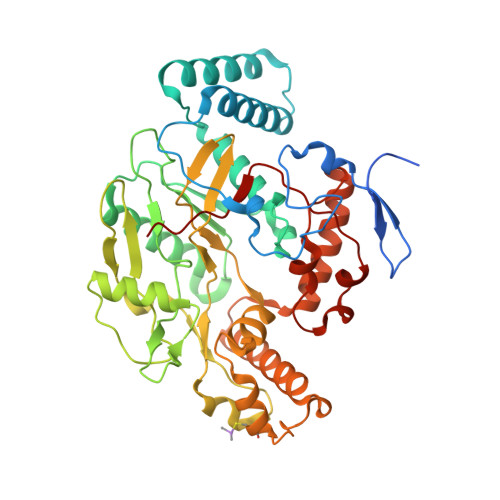Phenyl Ether- and Aniline-Containing 2-Aminoquinolines as Potent and Selective Inhibitors of Neuronal Nitric Oxide Synthase.
Cinelli, M.A., Li, H., Pensa, A.V., Kang, S., Roman, L.J., Martasek, P., Poulos, T.L., Silverman, R.B.(2015) J Med Chem 58: 8694
- PubMed: 26469213
- DOI: https://doi.org/10.1021/acs.jmedchem.5b01330
- Primary Citation of Related Structures:
5AD4, 5AD5, 5AD6, 5AD7, 5AD8, 5AD9, 5ADA, 5ADB, 5ADC, 5ADD, 5ADE, 5ADF, 5ADG, 5ADI, 5ADJ, 5ADK, 5ADL, 5ADM, 5ADN, 5FJ2, 5FJ3 - PubMed Abstract:
Excess nitric oxide (NO) produced by neuronal nitric oxide synthase (nNOS) is implicated in neurodegenerative disorders. As a result, inhibition of nNOS and reduction of NO levels is desirable therapeutically, but many nNOS inhibitors are poorly bioavailable. Promising members of our previously reported 2-aminoquinoline class of nNOS inhibitors, although orally bioavailable and brain-penetrant, suffer from unfavorable off-target binding to other CNS receptors, and they resemble known promiscuous binders. Rearranged phenyl ether- and aniline-linked 2-aminoquinoline derivatives were therefore designed to (a) disrupt the promiscuous binding pharmacophore and diminish off-target interactions and (b) preserve potency, isoform selectivity, and cell permeability. A series of these compounds was synthesized and tested against purified nNOS, endothelial NOS (eNOS), and inducible NOS (iNOS) enzymes. One compound, 20, displayed high potency, selectivity, and good human nNOS inhibition, and retained some permeability in a Caco-2 assay. Most promisingly, CNS receptor counterscreening revealed that this rearranged scaffold significantly reduces off-target binding.
Organizational Affiliation:
Department of Chemistry, Department of Molecular Biosciences, Chemistry of Life Processes Institute, Center for Molecular Innovation and Drug Discovery, Northwestern University , 2145 Sheridan Road, Evanston, Illinois 60208-3113, United States.





















